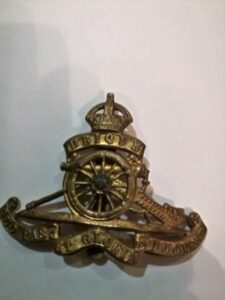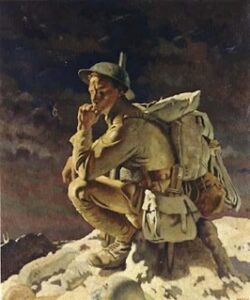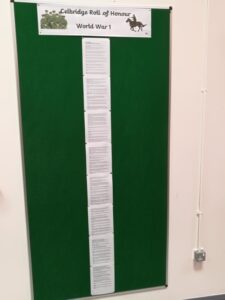Celbridge Roll of Honour
By Scoil na Mainistreach History Squad.
We decided to base our essay on the men from Celbridge who fought in the Great War. We started by looking at the list of 29 known dead compiled by historian Fionnuala Walshe. (1) We also looked at the Roll of Honour in Christ Church, Celbridge.

We then began to look for some of these men on the Census, in the Kildare Observer archive and on our old roll books. We were amazed to find ten of the dead in our roll books! This then lead us to ask more questions. How many men from Celbridge actually fought? Had many families sent more than one man? What backgrounds did they have? What made them go in the first place? We decided to compile our own Roll of Honour. We also wanted to find out as much about these men as we could and make sure they were not forgotten.
This is the story of our Celbridge Roll of Honour.
Recruitment in Celbridge
According to newspaper reports, between 200 and 290 men from Celbridge went to fight in World War 1.(2)

They fought for many different reasons. We saw from the census that many of the men were labourers and we thought they went to earn money; this was called taking The King’s Shilling. Many hoped they would be rewarded with Home Rule. Maybe some went because their friends were going and it would be an adventure which would be over by Christmas! Politicians were encouraging them to go and there was a big recruitment campaign (3)

Many enlisted because they were loyal to the U.K. Colonel Claude Cane said:
“Celbridge, I am proud to say, has as good a record as any place of its size in the Kingdom.” (4)
The Dease Family was a wealthy, powerful, Catholic family. Sir Gerald Dease was Chamberlain to the Lord Lieutenant. He was married to Emily Dease (Throckmorton). We think he was a kind and caring man. Once he had a party to celebrate his son William’s marriage. Gerald invited everyone in Celbridge rich or poor it did not matter.
The family was respected around the small village of Celbridge. There is a cross outside the Celbridge church which remembers his death. Emily and Gerald lived in Celbridge Abbey. When Gerald died she then moved in with her son William to The Cottage, Celbridge. The cottage was more like a mansion than a cottage! She died on the 2/12/1929 aged 87. (5)

We became very interested in Gerald and Emily’s son William Dease. We discovered many Celbridge men followed Major Dease to War. He married Gertrude Lascelles.(6) Gertrude wrote a letter, in 1915, to The Irish Times and told them that 87 men from Celbridge had enlisted as remounts following her husband Major William Dease.
She told them that the men, who were promised money to support mothers and smaller brothers or sisters, weren’t getting anything like they expected and on some occasions even nothing! She also said that it was very tough for the families to live with their sons gone fighting in the war. (7)

We thought it was amazing that 87 men from the tiny village of Celbridge had followed Major Dease! We wondered was it loyalty to the Dease family that made them go. When reading the letter we thought Gertrude felt responsible for the men.
Maybe they were impressed by William’s cousin Maurice Dease who was the first person ever to be awarded the Victoria Cross in WW1. (8)

William’s brother Arthur Joseph Dease was born in Celbridge in 1871. He was a volunteer ambulance driver and awarded a French Croix de Guerre in 1918. Arthur’s Letters is a website that has letters Arthur sent to his Mother during the war. These letters tell us a lot about life in the war and also how the men felt about fighting.
We noticed that Arthur didn’t really like the Home Rule idea!

He also mentioned multiple times that he was going to meet his brother William in Boulogne. Boulogne was where the Remounts were based. There was also a letter written by Arthur which in summary says that William got a kick in the face by a mule!
 (9)
(9)
The Remounts worked with horses in World War l. They groomed them, they fed them and they selected and trained the horses. (10)
We felt Celbridge lads would be ideal for the Remounts because Kildare is renowned for its horses and horsemen.

Family Sacrifice

(11)
We discovered many other local families who suffered greatly. Three brothers Edward, Patrick and Thomas Dempsey went to the Great War and none of them came back alive. The Dempseys were a very poor family from Long Lane.
Census records indicate their father Edward could not read or write and neither could his wife Ellen. There were 10 children in the family originally but only 8 survived by 1911. The brothers may have enlisted because they thought their mother would have got the allowances. They were farm labourers and able to read and write.(12)

(13)
The Dempsey lads went to our school. We found them on our old roll books.

(14)
Local historian Georgie Bagnall got in touch with the descendents of the Dempsey family and showed us photos, letters, documents and cards belonging to the men.


The letter is sad because Edward is explaining to his Mam that he couldn’t find out where his brother Thomas was.
Here we see Edward’s family looking for the money owed after his death.

O’Connor Family
Captain Hubert O’Connor went to fight in the Great War, he also had a brother, Frank, who was in the Belgian army service and a sister who was a Red Cross Nurse.
His family were obviously quite wealthy as he entered Trinity to study law. If he had pursued the profession of law he would have made his mark. He was later associated with the National Volunteers, and probably thought that loyalty would result in Home Rule. He was made an Officer in the King’s Shropshire Light Infantry. He was awarded a Military cross for Bravery in the Field. He was then promoted Captain and was on leave at home. He went back and shortly after died in action in Ypres (15)

(16)
Coincidental meeting of Celbridge Men
An article entitled “A Soldier Family” was published in the Kildare Observer. It said Thomas Connell was injured from shrapnel wounds on his body. He was treated in a hospital in Paris and was treated by Frank O’Connor brother of Captain Hubert O’Connor.(17)
5 or 6 Connell brothers from Celbridge fought! Their father worked in Celbridge Mill.
 (18)
(18)
Another article tells Sergeant Richard Connell’s thrilling experience in the trenches
 (19)
(19)
The Magan Family.
The Magans were a Protestant family who lived in Castletown.

They were an educated family, they could all read and write. The dad, William could also speak Irish and English.(20)
They were working for Major Connolly of Castletown. Frederick was Major Connolly’s groom. He joined the army and was assigned to the King’s Royal Irish Hussars as a private.(21)
His dad William and his brother Alfred also fought in the Great War. His brother, George, for some reason did not enlist. George was an amazing athlete. He was a famous GAA star and played in the all Ireland final for Kildare and they won! He later went on to be a Garda. We thought this was unusual considering his background.(22)
Frederick died in training and had a huge Military funeral in Celbridge.
His remains were brought from Dublin on a gun carriage covered with a Union Jack. The service was held in Christchurch then his remains were placed back on the gun carriage and brought to Donaghcumper and still lies there today. (23)
We came across the sad story of the Buckleys, their mother lost two sons and was left penniless and blind.
 (24)
(24)
The Abels sent 3 brothers John, William and George. John served in the R.A.M.C (Royal Army Medical Corps). William served in the R.W.F (Royal Welsh Fusiliers), George served in the R.M.F (Royal Munster Fusiliers). Their Dad was a grocer in Main Street. William was killed 13/11/1916 and George 22/3/18 aged 19. (25)
An Irish Airman

Charles Sheridan was born in Celbridge on 18th/1/ 1900, one of 12 children. We found his brothers on our roll book. His father was a cobbler. They lived at 35 Main Street but later on they moved to Drumcondra. (27) On the 14/7/18 he enlisted in the RFC and he worked as an Air Mechanic until the end of the war. He reenlisted on 17/2/19. He worked as an experimental pilot in Mendlesham Health Airfield. On the 16/8/1921 his aircraft crashed killing him and the pilot instantly. Charles is buried in Tea Lane Graveyard, walking distance from our school. Charles got a military funeral because he was in the air force and people who died before 1921 and who were in the First World War got a military burial (28)
We noticed that a huge slab was covering his grave. We wondered if his family were afraid that people who opposed British rule would interfere with his grave.
Christ Church
Christ Church (Church of Ireland) is just inside the gates of Castletown. It has a handwritten and a printed Roll of Honour of all the men from that parish that fought in the Great War. It also has a stone Celtic cross remembering those who died. The names range from ordinary working men like the Abels and Magans, to some of the richest like Maurice Cane of Wolstans. The Reverend of Christchurch at the time was J.W. Crozier. He himself went as the chaplain of the 10th Irish Division and fortunately survived. (29)

John Shaw’s grandsons still live in Celbridge. They let us see John’s medals and buttons and hat-badge. We could tell from the Star medal John was a Gunner in the R.G.A. 1914-1915. He also had a compass ring, we’d never seen one before! We discovered that John played for Meath in The Croke Cup! His grandsons are very involved in Celbridge GAA.



The Big Houses were well represented by their owners and staff. We wrote about Major Conolly and his groom earlier
Wolstan’s was owned by Colonel Claude Cane .When the war started, being a veteran, he wanted to join up. Sadly, he couldn’t as he was too old.(30)
His son Maurice was born in 1882. He went to Eton and Oxfo

rd. Nowadays the Royals would go to Eton! This shows how rich his family were. His family also owned all the land around St. Wolstan’s and the massive house itself. He enlisted in the Canadian Naval Volunteers and then his Father’s old regiment.
Maurice was a Second Lieutenant with the Royal Field Artillery. He was killed firing a machine gun in Flanders 1917. He was married and had one child.(31) There is a beautiful stained glass window in the church in Castletown dedicated to him, paid for by his father.
According to our research we think that Maurice Cane went to war not for the money but because he was part of a military family. We think that the family were loyal to the Crown and wanted to help them in any way possible.
We noticed that Hubert. J O’Connor was also killed in the 3rd battle of Ypres within a week of Maurice Cane, we wondered if they were friends.
The third battle of Ypres took place in 1917. It was known as Passchendale. It began with huge guns shelling German lines. Over 4 and a half million shells were fired. After 2 weeks the shelling stopped and the Allies moved in on the 31st July. The Germans soon counter-attacked. Shells and machine guns were fired at them. To make it worse it started raining. The battle lasted 10 weeks! In November the Allies finally controlled Ypres. (32)
Killadoon is owned by the Clements family. There were two representatives from the family, Henry T.W. and Henry Theophilus. Henry served in India and on the Western Front. He got frostbite and a wounded leg and finished the war as a Colonel. His son Henry Theophilus saw action in France and again in World War 2. They fought with the Royal Field Artillery.(33) The Clements family still live in Killadoon to this day.
Pickering was owned by Lt. Brooke who died Oct. 7th 1914 from wounds while fighting for the Expeditionary Forces. (34)

Richard Maunsell
During our field trip we went to Oakley Park where Richard Maunsell lived. He went to Trinity College and became a barrister.
He enlisted in 1915 as a lieutenant in Kitchener’s Army and in 1917 was awarded an OBE. (35)
His wife Molly was a cousin of William Orpen who was an Official War Artist.

(36)
Donaghcumper was owned by the Kirkpatrick’s, a very wealthy family. Sir Ivone Kirkpatrick was born 3/2/ 1897 He left school to enlist and was a lieutenant in the Royal Inniskilling Fusiliers. He got very badly wounded. He was awarded a Belgian Croix De Guerre He was a Spymaster later in the war and became a high ranking diplomat. We thought he really looked like a spy! We visited his family grave; they were all in the military some way. He died in Celbridge in 1964 and is buried in Donaghcumper. (37)
(37)
We were amazed that so many people had joined up from a small village with a population of around 1500. We were also amazed that so many families sent more than one man. We feel like we got to know these men and their families. These men came from different backgrounds rich to poor, Catholic to Protestant and Private to Colonel. We found it a lot easier to find information about the rich and powerful than the poor. We think poorer people went for the money and richer people for political reasons. We hope that this essay and our Roll of Honour will help us remember all the men from Celbridge who fought in The Great War.

(38)
Bibliography and References
- The impact of the First World War on Celbridge.
- Irish Times Monday 9th of August 1915.
- Trinity collection WW1 Recruitment posters.
- Kildare Observer 18/9/1915.
- Kildare Observer 14/12/1929 .
- Kildare Observer 11/9/1897.
- Irish Times June 4th 1915 – letters.
- co.uk.
- com.
- The story of the First World War for Children.
- Leinster Leader 23/10/1915.
- Census of Ireland
- Our Celbridge Roll of Honour– compiled from Kildare.ie, Christchurch Roll of Honour, Kildare Observer and local knowledge
- Register of Abbey Male National School 1873-1905.
- southdublinlibraries.ie
- War Notes Kildare Observer 7/11/1914.
- Kildare Observer December 5th
- Kildare Observer October 17th
- Kildare Observer March 22nd
- Census of Ireland
- ie.
- https://en.wikipedia.org/wiki/George_Magan_(Gaelic_footballer)
- Kildare Observer March 13th 1915
- Kildare Observer April 6th
- ie.
- An Irish Airman Foresees his Death WB YEATS
- Census 1901
- Charles James Sheridan 276580 Royal Air Force 1900 – 1921 Seamus Cummins.
- Irish Times 25/3/1915.
- War Notes Kildare Observer.
- Kildare Observer 18/5/1917.
- The story of the First World War for Children.
- com
- southdublinlibraries.ie
- com
- The Thinker – On the Butte de Warlencourt by Sir William Orpen
- New York Times May 26 1964
- Joining the Colours Katherine Tynan
We would like to thank Local Historians Jim Tancred, Georgie Bagnall , James Durney , and Breda Konstantin for all their help. We are also very grateful to Reverend Stephen Neill and John Lougheed for allowing us visit and learn about Christchurch, Celbridge.